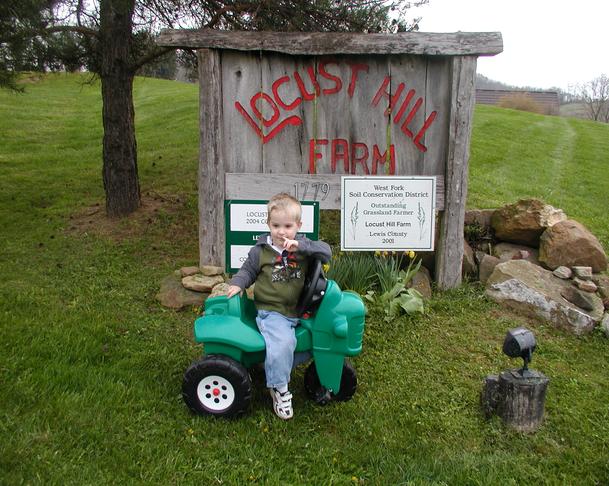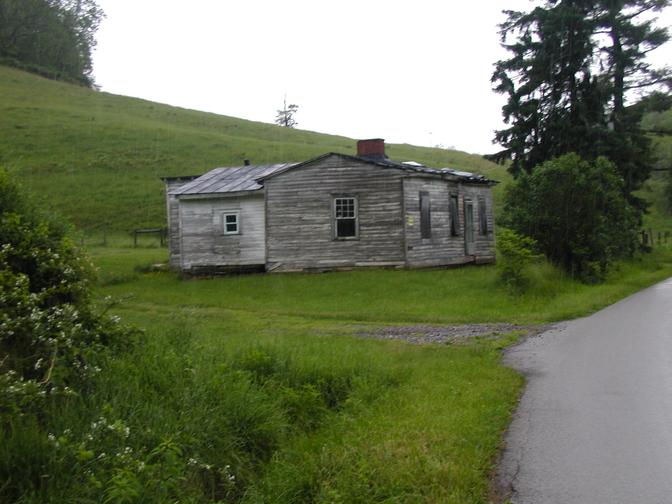
| Next Chapter | Previous Chapter | |
| Chapter 22: Cuttin’ Filth | Contents | Chapter 20: Our family and the Jesse Run farm |
This is a book about change, and this is one of the greatest changes. My grandfather Kennedy could remember cradling wheat - cutting it with a special scythe which had several wooden rods the shape of the scythe blade and parallel to it to bunch the straws. When you swing the scythe, the stems of the plant were caught on the rods, and when you drew the scythe back to get another swing the stems, with the heads of wheat aligned were dropped neatly in a pile. Then someone would come along and tie the bunch with a handful of straws, so it could be handled conveniently with a fork. Sometime shortly after he married grandmother they began to buy flour in barrels imported from the West. Prior to that time only sugar and salt were purchased in bulk.
In my youth a wheat binder was used to get sheaves of wheat ready to thresh, but the wheat was used only for animal feed. There was plenty of labor after the sheaves were made. Usually six or eight bundles were set upright, then two more were bent in the middle and laid across the tops to make a sort of cap. Sometime later, a wagon would come along and men with pitchforks would load the sheaves and take them to the thresher. The thresher was powered by a tractor in my time, but horses had been used with earlier threshers. It was a lot of work to throw the bundles of wheat into the thresher, to bag up the separated grain, and remove the straw. This intense labor was typical of farm operations at the beginning of my memory, and intense gang labor had been the way for, literally, thousands of years. Actually, I got in after a lot of improvement had been made, right before full mechanization.
The traditional wage in my youth was a little above "a dollar a day, and all you can eat," the wage that had prevailed for some years before and during the "Great Depression." For a single farm laborer, the "all you can eat" was a significant benefit. Farm wives took pride in the table they set. Anyone who lived alone, and also many who lived with a laboring family, didn't have much to look forward to at meal time. Many poor rural families used lard on their bread and sold any butter they could produce for much needed cash.
(Illustration 21-1)

Matthew at our farm sign
I have heard many stories of how farmers in depression years traded food for labor. Milk and potatoes were staples, and pork was a small luxury. I once heard a story about a miner who worked at Righter who lived on bread and pork bellies for fifteen years before returning to Italy.
A few years ago I read the production and preparation of food were almost the same in the colonial era as they were in Roman times, 2000 years earlier. This was true for most everything else, too: communication, making metals, building, medicine (almost nonexistent, although some were trained to perform that function), transportation. The principal change in technology by colonial times was in the way of making war.
Agriculture had made some change by my youth, but over half of the population was still engaged in producing raw food. Why I make the distinction, saying raw food, is that it was a short road from the farm to the consumer in my youth. Food was sold without much change between the farmer and the cook who prepared the food in the home. Today no more than 2 percent of the population have a hand in food production, and most of them are part time farmers. Several times that many are involved in processing, transporting, and retailing it. Over one-third of the meals are served outside the home in restaurants and institutions like schools, jails and the military,
There were a lot of respectable people who were farm laborers - in fact most farm laborers were respectable. Not much learning was involved, much of the work was intuitive. The farm laborer had to demonstrate willingness to exert himself, and if you were clean, well spoken, and had good manners, that helped get a job. Managing a farm was a considerable step up and required lots of initiative. You could be a laborer just by appropriate response to direction by others. It was a passive occupation, like so many today. If you were a farm owner or manager, there was always someone else who would like to have your resources if you couldn't do well enough to keep them.
I discuss haymaking and how it has changed elsewhere, and also making silage. There have been no cash crops sold directly to the customer in my experience, except a patch of strawberries when I was a teenager. And Dad, of course, had the dairy that I saw as a child.
(Illustration 21-2)

This is the tenant house on the Lewis Swisher farm. It is badly run down now, but it exemplifies the typical dwelling provided for families who provided farm labor in the past. It had three rooms, boards on the outside and inside of the studs, but no insulation between, open fireplace for heat, outside pump well and outhouse.
The only walking jobs now are making fence and working cattle. We have never used horses to work cattle in our small fields. There are no arm muscle jobs, except making fence, and much of that is gone since I quit making fence posts from Locust trees about 1996, in favor of buying pine posts treated with chromated copper sulfate, and driving them with a hydraulic post driver. Most of my posts now come from Ripley, a three hour drive each way, or McAurthur, Ohio, about four and a half hours each way. It would be hard to explain to Dad or Grandfather why it is cheaper to buy posts at $7.00 than make them myself (or hire it done) from trees growing on the farm.
All the work is done from the tractor seat. Hay making, feeding it out, cutting filth, making roads, everything with the exceptions mentioned in the last paragraph. Working cattle is the only group labor where people have to cooperate. "Working" cattle requires getting them in to the pens and giving vaccinations, ear tags, medicines. This requires a crew of six or so. We call on cousins to help when we can't do it all ourselves.
One of the consequences of driving around on a tractor is that you don't see as much wildlife. Deer learn to ignore you, and turkeys are beginning to. But the rest of the animals you seldom see unless you walk. I have seen few snakes in recent years. Coyotes are out there, but I never see them. My hunters tell me they are there, and sometimes you see one from a great distance, and they kill a few calves.
Aside The greatest change in farming, from my point of view, in my lifetime is this: When I first went out to the fields, work was gang labor - many people were involved and the product was directly proportional to exertion by human muscle. Now work is mechanical and proportional to diesel fuel burned and with the exception of working cattle, only one person is involved in doing it. Human muscle is used for accessory work and control. In other words, what was once communal work is now very lonely. The very substantial investment in required machinery and materials is the other side of the same coin.
| Next Chapter | Previous Chapter | |
| Chapter 22: Cuttin’ Filth | Contents | Chapter 20: Our family and the Jesse Run farm |
Copyright © 1998, 2006, 2008, 2011 S. Tom Bond (stombond at hughes.net)